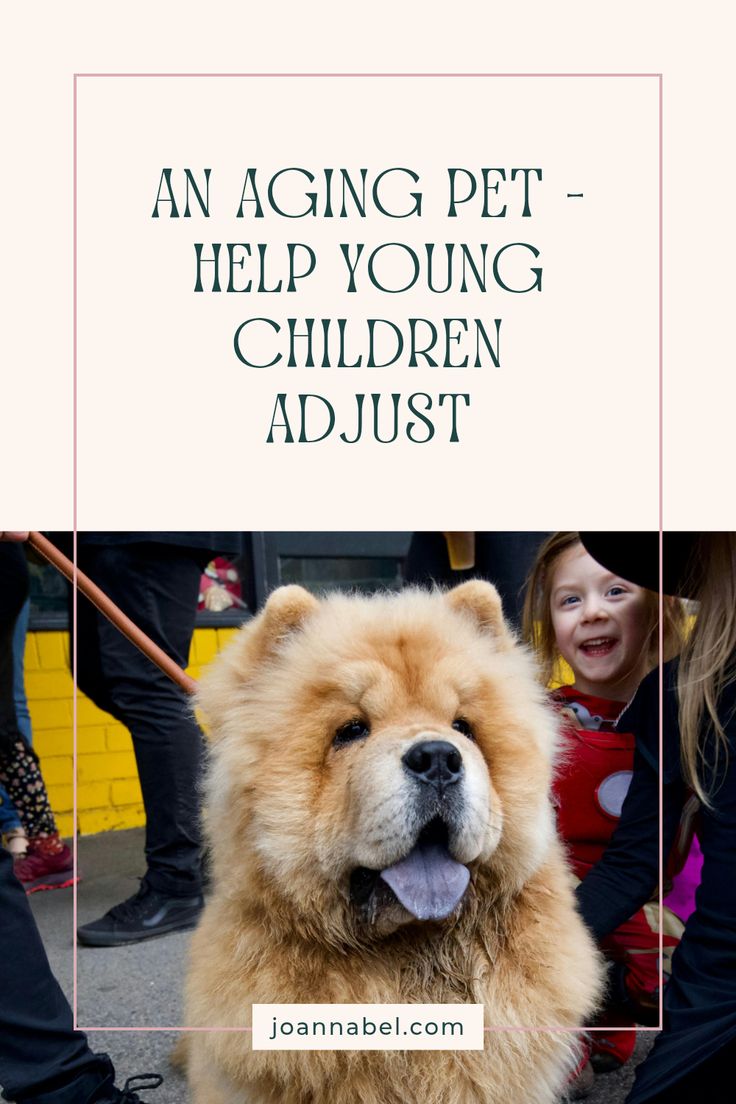The bond between a child and a pet is special, filled with affection, laughter, and plenty of memorable moments. Yet, as pets age, their energy diminishes, their care needs become more complex and these changes can be confusing for young children who may not fully grasp what’s happening. Young kids tend to associate things and events with themselves and with this in mind you can take action to prevent that from happening in this case. Parents can help young children adjust to the aging pet’s needs successfully.

An Aging Pet: How Parents Can Help Young Children Adjust
It can be done with patience and open communication, helping your children navigate these adjustments in a way that nurtures their compassion and understanding over time.
In this post we’ll discuss how you can do so successfully.
Note: Although I am a Clinical Social Worker, engaging with this website does not establish a professional social worker-client relationship. The information provided here is for general purposes only and should not be considered professional advice. While we strive to ensure accuracy and reliability, this content is not a substitute for professional guidance. For specific concerns, issues, or situations, it is essential to consult a qualified professional and present your situation. Read the full Disclaimer here.
This post has affiliate links which means that we make a commission from qualifying purchases at no additional cost to you. For more information read our Affiliate disclosure.
AN AGING PET: HELPING CHILDREN ADJUST
The bond between a child and their pet is unlike anything else in this world. Pets bring forth a source of immense joy and comfort, but the inevitable aging of a beloved animal can bring about a range of complex emotions for young children.
Navigating this delicate period requires you as a parent to be a sensitive guide, helping your child(ren) understand the changes their pet is experiencing and preparing them for the potential loss of a family fur baby.
By fostering open communication, providing age-appropriate explanations, and creating opportunities for meaningful farewells, parents can help their children adjust to the reality of an aging pet and learn valuable lessons about life, love, and loss.
Let’s get into more details on these helpful tips for helping children adjust when you have an aging pet in your household.
EXPLAIN CHANGES IN AN AGE-SENSITIVE MANNER
Kids are naturally curious, which opens the door for honest, age-appropriate conversations. Share what’s happening with the pet’s health, focusing on how their bodies work differently now.
Instead of using vague wording such as, “They can’t play like they used to,” try using language like, “Their legs get tired more quickly because they’re older.” This straightforward approach makes it easier for young minds to connect the dots without undue worry.
You might also discuss how the pet is still the same loving companion, even if their activities change. This brings reassurance to kids that their bond remains strong, no matter what physical or behavioral shifts occur.
ENCOURAGE GENTLE CARE
Shifting from boisterous play to a gentler interaction takes practice, especially for energetic children. Help them learn how to handle your aging pet with care.
Demonstrate gentle petting and quieter play activities, such as offering treats or brushing their fur.
It may also help to involve your child in caregiving routines, like refilling your pet’s water bowl or helping with meals.
These small tasks teach responsibility while strengthening their connection. Plus, they will begin to understand the importance of meeting their furry friend’s evolving needs.
ADJUST EXPECTATIONS FOR PLAY AND ACTIVITY
Active kids might feel frustrated when their aging pet can’t join their favorite games anymore. Activities like running, fetching, or long hikes may no longer be feasible.
Offering alternatives can ease this disappointment. Suggest less physically demanding play, such as sitting on the floor and using toys to entertain the pet in short bursts.
When outings come into question, a dog stroller might be a great option for your family, especially if your children want to bring your senior dog along on family adventures. (However, not all pets will be able to come along anymore, so finding ways to play at home will be crucial.)
Let’s mention a handy dog stroller for you to check out.
Paid Link: PAWZIDEA Large Dog Stroller with Detachable Carrier – Foldable, All-Terrain Pet Jogger & Car Seat Crate
The PAWZIDEA Dog Stroller helps ease the transition for aging pets, allowing them to continue enjoying outdoor adventures without strain or discomfort. Its detachable carrier provides a familiar, cozy space for car rides, reducing overwhelm and making vet visits or family outings less stressful.
The smooth, all-terrain wheels and shock absorption ensure a gentle ride, so pets with mobility issues can still experience fresh air and engagement with their surroundings.
With easy access, breathable mesh windows, and ample storage for essentials, this stroller makes it simple to care for and comfort your pet as they adjust to aging.
SHOW KIDS HOW TO GIVE SPACE WHEN NEEDED
Aging pets often need quiet moments away from the adventure-packed lives of their younger family members. Whether it’s a cozy corner in the living room or a favorite sunny spot, establish safe spaces your pet can retreat to.
Explain to your child the importance of respecting these boundaries. You can compare your pet’s needs to how your child feels after a busy day at school or a playdate, making the concept accessible and relatable.
ACKNOWLEDGE THE TIME YOU SHARE
Even with the realities of aging, there’s still so much joy to find in the companionship of a senior pet.
Make an effort to create special moments that fit your pet’s capabilities, such as cuddling during kids’ storytime or taking short, leisurely walks.
Encourage your child to show love in simple ways, like drawing pictures of the pet or sharing memories they made together.
These activities not only nurture the bond but also create lasting keepsakes for the family to cherish long after.
Latest Posts:
- AUTHORITARIAN VS. AUTHORITATIVE VS. PERMISSIVE PARENTING STYLE

- Reconnect With Your Teen: 5 Fun Bonding Activities

- Staying Connected With Your Child While They Study Abroad

- How To Help Your Child Get Engaged With School

- How To Divvy Up Rooms After Moving to a New House

- Ways To Help Your Child Mentally Prepare for a Move

FINAL THOUGHTS ON HELPING YOUNG CHILDREN ADJUST WHEN HAVING AN AGING PET
Sharing life with an aging pet can help kids develop empathy. When parents handle this transition with care, they can strengthen the relationships within the family, both human and animal alike. Parents can help young children adjust to their aging pets’ needs by focusing on open communication, shared experiences, and gentle guidance.
If you found this helpful read also:









Leave a Reply